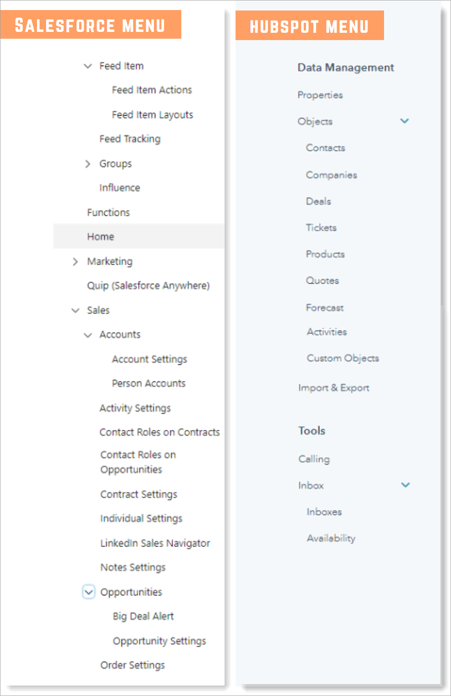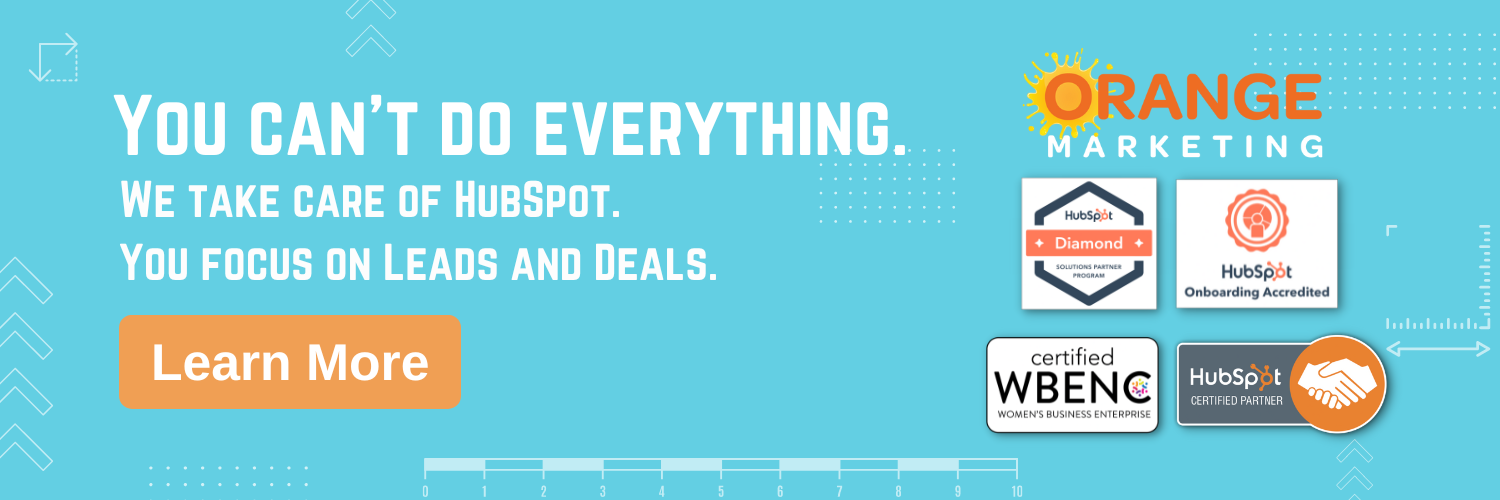3 min read
5 Reasons Startups Should Choose HubSpot Over Salesforce
![]() Orange Marketing
:
January 25, 2023
Orange Marketing
:
January 25, 2023

Salesforce.com is a powerful platform. One of the first truly configurable SaaS CRMs (remember the no software logo). The world of Benioff has become a behemoth with its own zip code. They host 40,000 people at their annual Dreamforce event, have a foundation that supports global causes, and employ a zillion smart people. We greatly respect the company, the product, and the people. Despite its success, however, Salesforce is not always a good choice for startups. There are several reasons why this is the case.
We think of this in terms of opportunity cost. For your startup, time is money. Resources are tight, both on the technical and go-to-market side. In the latter, you may have none! In the former, you want your team to work as efficiently as possible on your product. You are sub-optimized if they spend time managing data and dealing with tiny CRM/marketing automation issues instead of selling or coding. We’re not making this argument based on hard costs- it’s practically a wash there, but the soft costs will kill you.
The Soft Costs
1) Administrative
First, admin support for Salesforce is necessary for the implementation and ongoing maintenance. The platform is robust, with many settings and overlapping components. There are layers of permissions, page layouts, page visibility views, and so forth that a dedicated administrator must coordinate for all users, which can be expensive for a startup - whether you “rent” (hire a contractor or firm) or “own” - (hire a full-time employee.)
On the other hand, HubSpot (our preferred CRM and partner) is relatively easy to use. Anyone can get the basics going on the free CRM using the setup wizard in a single afternoon. That’s not necessarily true with Salesforce.
In comparing the “expanded” Salesforce settings menus below, you can see how different just the user interface is.

2) Marketing Integration
Second, integrated marketing is harder to manage and less successful. Salesforce was designed to be interoperable between sales, service, and operations, but it is less effective than HubSpot when it comes to integrated marketing. Without a dedicated Salesforce administrator, it is difficult to set up automation to trigger marketing reactions/notifications from sales activities. HubSpot, on the other hand, is designed to make setting triggers up easy for various staff members.
As a simple example, let's look at setting up notifications, which can immediately make your sales reps more productive. In HubSpot, a sales rep can easily set up their own notifications for things like a marketing email click or a website visit - AND they can select how they want to receive that notification. In Salesforce, creating this notification is a multi-step process requiring an adminstrator.
3) Outbound Sales
Third, outbound sales efforts with third-party tools create human and technical overhead. Salesforce is not built for outbound sales, so you need to use a third-party tool like Outreach or SalesLoft. These tools are great, but they have specific settings and require integration with Salesforce, which means anytime you make a change in one system, you will have to change it in both systems, which is time-consuming.
Beyond mapping fields, you will have to map your statuses and stages between Salesforce and other tools you use, which is typically more challenging than it sounds because they often don't map one-to-one. So a lot of time will be spent setting up and m maintaining fields.
That time suck moves us to our next topic: keeping data synced, which can be a time-consuming nightmare.
4) Maintaining Data
Maintaining (or syncing) the data between three or more platforms (e.g Salesforce, your Marketing CRM, and your outbound calling CRM) is a giant waste of time for a startup. Keeping data clean and managed without efficient tools requires a lot of labor—labor that can be spent on more strategic activities.
Staff who spend time keeping your MailChimp, Salesforce, and Salesloft in sync should spend it doing something else, such as creating new marketing campaigns, doing more sales outreach, or coming up with a new way to get in front of your customers or prospects. Keeping the data clean and managed is a waste of time you don't have to spare.
5) Buy-in Issues
Finally, Salesforce adoption is more complicated. Salesforce's user interface is more complex than other platforms , and training adds to the overhead. On the other hand, HubSpot has solid customization, making it easier to show sales reps only what they need to see, which makes training simpler and adoption better.
In short, Salesforce is a fine sales CRM, but there are more effective choices for startups. Setting up and maintaining Salesforce requires time and effort, and requires an additional software buy around outbound sales and marketing CRMs. HubSpot is a better choice for startups, as it is easier to use, includes all software needed, and requires less time and effort to set up and maintain.
Want to Learn More About HubSpot?
We help B2B software and technology companies develop their sales and marketing processes. We have a particular focus on startups and an excellent command of HubSpot, with more than 120 HubSpot Certifications and over 65 five-star reviews in HubSpot's Partner Directory. Let's get you rocking with HubSpot in 2023!
Additional Resources:
Three’s A Crowd: Why Adding Outreach Or Salesloft To Your HubSpot/Salesforce Integration Is A Bad Idea
Why Moving From HubSpot To Salesforce Won't Solve Your Sales Problem
HubSpot Sequences Vs. Workflows: What's The Difference?
